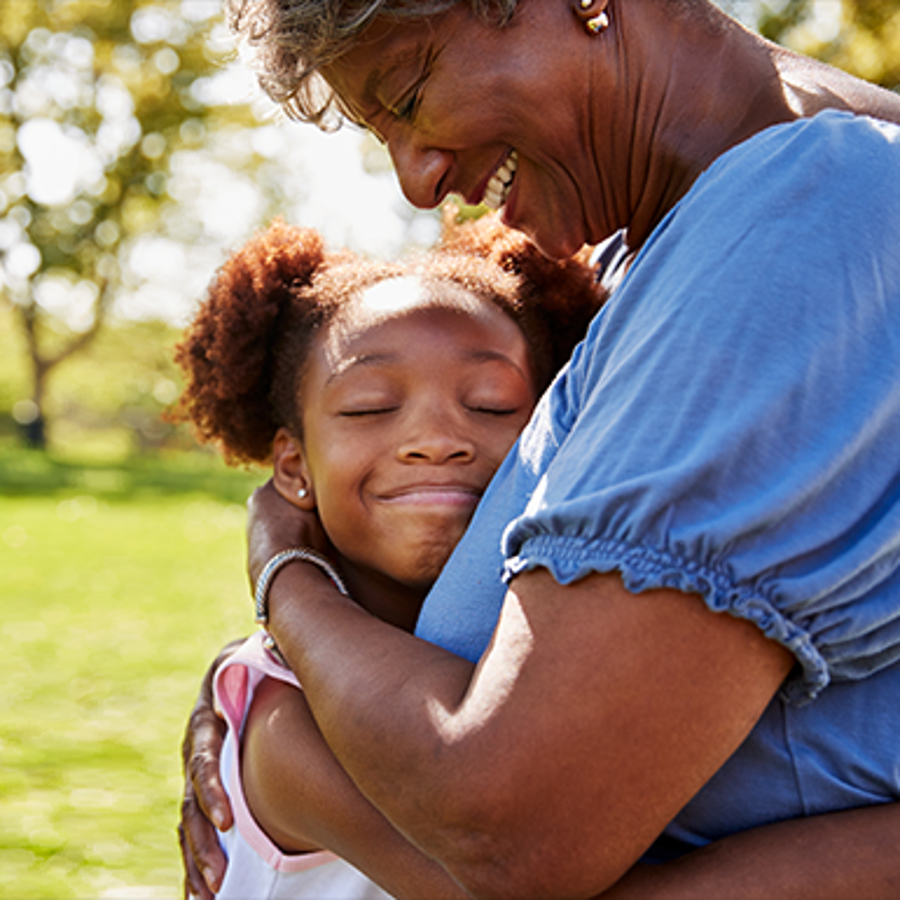
Do women share more than 25% DNA with a paternal grandmother?
November 2, 2011

- Related Topics:
- Recombination,
- Relatedness
A grandmother from the U.S. asks:
"I have heard that women who have granddaughters from their sons share more than the usual 25% of their DNA. Is this true and why does this happen? I have a granddaughter from my son and wonder if we share more than 25% of our DNA."
You're right! A grandmother shares a little bit more than 25% of her DNA with the daughter of her son. Instead, she shares on average about 26% of her DNA.
The reason has to do with the X and Y or "sex" chromosomes. For all other chromosomes, a grandmother shares about 25% of her DNA with each of her grandchildren.
But a paternal granddaughter ends up getting an X chromosome that is almost exactly the same as her grandmother's. This lets her share a little extra DNA with that grandmother.
The math
If you're interested, here's the rough calculation for how it is that 26% of DNA is shared between the grandmother and granddaughter.
The grandmother and granddaughter share around 25% of the non-sex chromosomes. That's around 1.4 billion letters of shared DNA, out of the ~5.75 billion letters in those chromosomes. But they also share their entire X chromosome, which is another 156 million letters of DNA.
(If you want to know the exact length of each chromosome, you can find that here.)
That means they share ~1.6 billion letters of DNA, out of the ~6.1 billion total DNA letters in a woman's genome.
But these are just averages. A grandmother and granddaughter might share more or less than this, just because of chance and random genetic shuffling.
Explaining how this happens is a bit tricky. So to make it easier, we'll use some pictures.
Passing Down Chromosomes
Just like a book is broken into chapters, our DNA is broken up into separate pieces called chromosomes. There are 23 different chromosomes in humans, as if our DNA was spread over 23 chapters. Every person has two mostly identical copies of each chromosome – we get one from our mom, and the other from our dad.
So in our pictures, a person will be shown as a pair of chromosomes. But keep in mind – there are 22 other pairs of chromosomes that we aren't showing!
Before a chromosome gets passed down to a child, the two chromosomes in each pair swap DNA. As you can see in the image below, the result is two, brand new, unique chromosomes. This is called recombination.
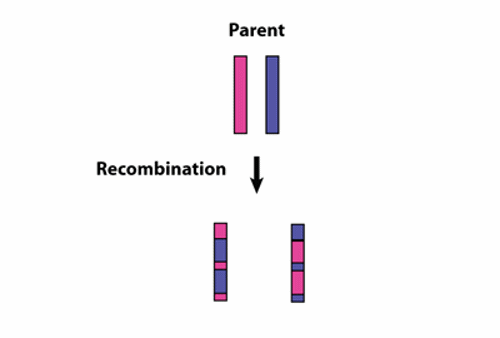
One of these mixed up chromosomes is then randomly passed down to a child. Below, see what happens when recombination happens in a dad and he has kids.
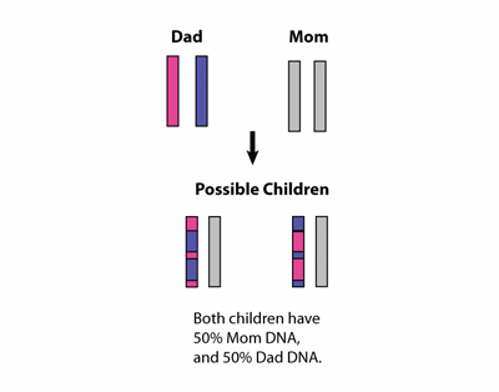
(We aren't showing DNA swapping in the mom even though it happens! Also note that this is just one way the chromosomes might have swapped their DNA. There are nearly an infinite number of possible combinations!)
Since Dad passes down only one chromosome to his child, he shares 50% of his DNA with each of his children. The same goes for mom. And a child shares 50% of his or her DNA with each of his or her parents.
For simplicity, let's name the dad John. Where did John get each of his chromosomes? He got one from his mom, and one from his dad, as you can see below.
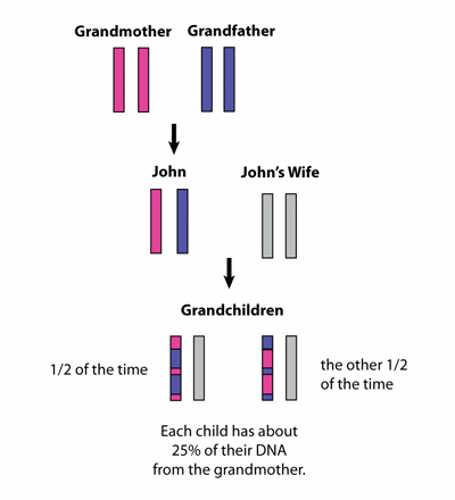
(You may have noticed that we didn't show the chromosomes of the grandparents, or of John's wife, swapping DNA. They actually do – but that would make a more complicated picture. So just keep in mind that they do swap DNA in reality.)
Back to the picture. The grandmother shares half of her DNA with John. And John's children each get only half of their DNA from him. So this means that the grandmother shares a half of a half of her DNA with each of her grandchildren – or 25%. Just those little bits of pink in the picture.
This is why grandparents share on average 25% of their DNA with their grandchildren. The exact amount depends on how much DNA is swapped. But when you look at all 22 pairs of chromosomes (not just the one pair above), it averages out to around 25%.
If this is all there was to it, grandmothers would always share about 25% of their DNA with their grandkids. But we know that some granddaughters are a bit more related to grandma.
Grandma's X Chromosome
Finally, we're at the answer to your question. There is a pair of chromosomes that don't swap much DNA. These are the X and the Y chromosomes, or the sex chromosomes, in men.
If you have two X chromosomes, you are a female. If you have one X and one Y chromosome, you are a male. (You got a Y from your father and your X from your mother.)
DNA can only be swapped between matching chromosomes. Two chromosome 1's can swap DNA, and so can two chromosome 2's, 3's, etc. A woman's two X chromosomes also swap DNA. But a chromosome 1 won’t swap with a chromosome 3. And because they are also different, a man's X and Y don't either.
Take a look at what happens now when we focus on John's X chromosome:
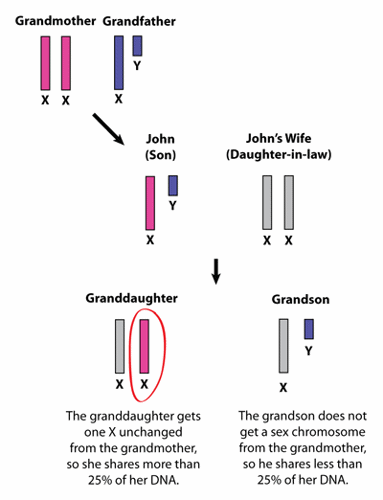
(To keep it simple, we're still not showing the DNA swapping that happens in John's wife and in the grandparents.)
So, John has a Y from grandpa and an X from grandma that don't swap much DNA. John's daughter actually gets John's X chromosome completely unchanged. And it is the same X that John got from the grandmother. This is what makes the granddaughter and the grandmother share more DNA!
DNA sharing for all the other 22 chromosome pairs is around 25%, as we showed before. But for the sex chromosomes shown above, there's a little bit more sharing. John's daughter has a bit more of the grandmother's DNA and a little bit less of the grandfather's! And as you can see, the grandmother shares a little bit less DNA with John's son.
To make it even clearer, we can compare this to what happens if a grandmother and grandfather had a daughter (with two X chromosomes) instead. As you can see below, DNA can swap between the daughter’s X chromosomes.
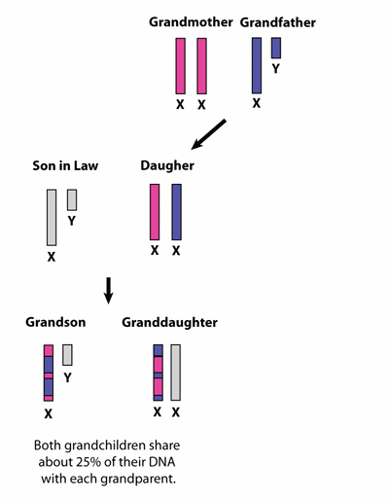
The children of the daughter share with their grandparents the normal 25% of DNA on the sex chromosomes. This happens for their other 22 pairs of chromosomes too. So a maternal granddaughter and grandson are equally related to grandma.
Let's put the whole family together now. We'll show recombination happening in the grandparents and daughter-in-law, too.
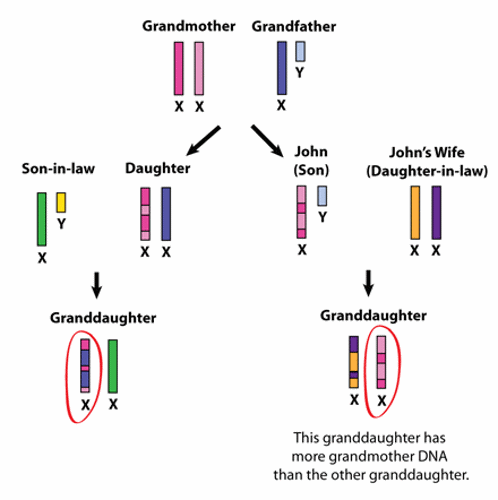
You can see that John's daughter has a little bit more of the grandmother's DNA on the X chromosome than does the maternal granddaughter. (Just a bit more dark pink and light pink.) So John's daughter shares 26% of the grandmother's DNA – but the other granddaughter shares the normal 25%.
For people who want even more information about relatedness, here you go!
Are there any other cases where there is extra sharing?
Yes! If John had a son, he would get John's Y chromosome. This Y would be the same as the grandfather's. So, John's son and his paternal grandfather share the exact same Y chromosome.
What about the mitochondria?
We didn’t get into this above, but there's also another type of DNA we haven't talked about. The chromosomes we mentioned before were in our cells in a compartment called the nucleus. But there is also DNA somewhere else.
This DNA is inside the mitochondrion, a different compartment of each of our cells. The mitochondria make the energy for our cells, almost like powerhouses. To do its job, the mitochondrion has its own DNA. This mitochondrial DNA (mtDNA) is separate from the 23 pairs of chromosomes we’ve been talking about.
The catch is that children get all of their mtDNA from their mother. It's not the usual 50/50 split between mother and father. So if we include mtDNA, a child actually always shares a little bit more DNA with his or her mother. And so a grandchild would also share a little bit more DNA with his or her mother's mother, too!
But we're not talking about a whole lot of DNA that's in the mitochondria. It adds less than 0.001% to the amount of DNA shared between a mother and her child. So it isn't nearly as significant as what we have been talking about up until now. We just thought we should make the story complete.
Are there any consequences of a grandmother sharing a little more DNA with the daughter of her son?
Maybe. Take a look at this article and decide for yourself.

Author: Julie Granka
When this answer was published in 2011, Julie was a Ph.D. candidate in the Department of Biology, studying inferring historical processes from genetic data in Marc Feldman's laboratory. Julie wrote this answer while participating in the Stanford at The Tech program.
 Skip Navigation
Skip Navigation
